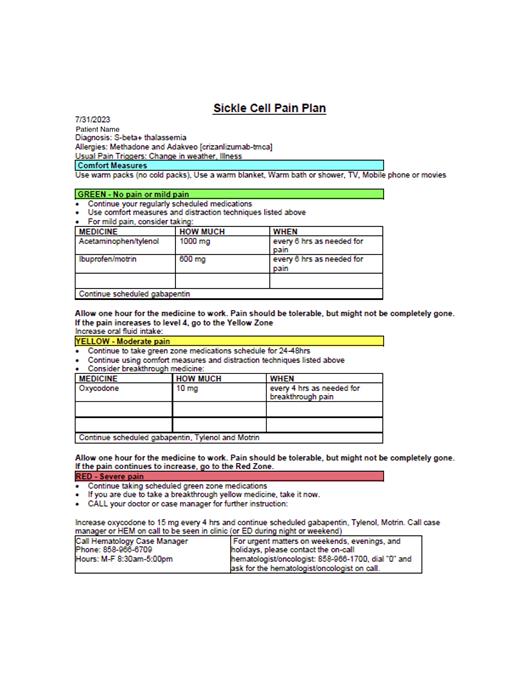Background: Patients with sickle cell disease (SCD) experience recurrent vaso-occlusive crises (VOC) as a primary manifestation of their illness. The American Society of Hematology (ASH) best practice guidelines recommend that individuals with SCD have individualized care plans to effectively begin pain management at home prior to presenting to the emergency room. A needs assessment of the comprehensive sickle cell program at Rady Children's Hospital San Diego (RCHSD) identified the need for a standardized approach for the provision of Pain Action Plans (PAP). In 2022, an outpatient PAP Quality Improvement (QI) project was initiated at RCHSD with the global aim to improve outpatient pain management and quality of life for patients with SCD.
SMART Aim: Within 6 months (January-June 2023), to increase the proportion of patients with SCD receiving a PAP during a comprehensive clinic visit from 0 to 50%.
Methods: The QI project was conducted by an interprofessional team with clinical, QI, and information technology expertise. An initial approach utilizing the Med Action Plan function in EPIC had technical challenges and was not implemented. We identified an existing Epic Asthma Action Plan which could be adapted to a SCD PAP. Meetings with clinical informaticists, pulmonology (consultants), and hematology teams informed the QI tools (process mapping, key driver and Ishikawa diagrams) that we used to design our PDSA cycles. The PAPs were modeled after the existing Asthma Action Plan, with green, yellow, and red zones to indicate different levels of pain management. Patients were given laminated Youth Acute Pain Functional Ability Questionnaire (YAPFAQ) and a comfort measures sheet to complete prior to their visit with the provider to inform the PAP which included pain medication details and supportive care measures for each zone. PAPs were created within the clinic note at comprehensive clinic visits and then provided to the family as a printed letter in person and via MyChart (if activated). Our outcome measure was the percentage of patients who were provided a PAP at their SCD comprehensive clinic visit. Process measures included the percentage of patients who had documentation in the PAP of the YAPFAQ and comfort measures, percentage of patients who had a PAP routed to patient via MyChart, percentage of patients who confirmed receipt of their PAP, percentage of patients who had used their PAP by parental report after one week, and percentage of patients who had used their PAP after 3 months per Epic documentation. Balancing measures were the perceived burden of patient care/documentation for the PAP to be evaluated with pre and post surveys among providers.
Results:
Interventions were evaluated using PDSA cycles. PDSA Cycle 1 (January-March 2023) included development of the SCD PAP by adapting the existing Asthma Action Plan to a SCD PAP. This included the creation of medication templates, integrating comfort measures and pain triggers, creating EPIC smart phrases to document the YAPFAQ. We educated providers on the SCD PAP and documentation process and worked with the interdisciplinary team including case managers, nurses, child life specialists, and psychologist to incorporate YAPFAQ and comfort measures into the comprehensive clinic visit. PDSA Cycle 2 (April-June 2023) included additional education, training, and targeted e-mail reminders to hematology attendings.
From May 2023 to July 2023, 94% percent (13/14) of patients seen at a comprehensive clinic visit received a PAP. One patient had the PAP created but did not receive the printed letter due to time constraints for family. Feedback from families indicated that they felt the PAP was a valuable tool to have at home during VOC, however none had yet utilized it in the week since they were seen in clinic. Early provider feedback has indicated that this functionality is easy to use and efficient during the comprehensive clinic visit.
Conclusion: The adaptation of the Asthma Action Plan to the SCD PAP allowed for successful implementation of PAPs for our patients with SCD. Subsequent PDSA cycles will focus on optimizing implementation in the clinic and utilization for pain events. We will evaluate the clinical impact of the PAPs on pain management outcomes.
Disclosures
Thornburg:Novo Nordisk: Research Funding; BioMarin: Research Funding; Sanofi: Honoraria.


This feature is available to Subscribers Only
Sign In or Create an Account Close Modal